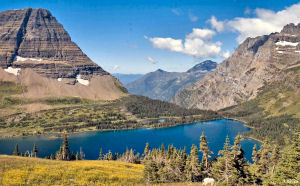| Montana can be divided into two geographic areas in general. The eastern 3/5 of
Montana is covered by the Great Plains and the western 2/5 of Montana is the Rocky
Mountain Region.
The Great Plains of Montana are part of the Interior Plain of North America
that stretches from Canada south to Mexico. The Great Plains are made of high,
gently rolling land interrupted by hills and wide river valleys including the
Yellowstone and Missouri Rivers. Groups of mountains spring up from these plains;
the Bear Paws, Big Snowy, Judith, and Little Rocky Mountains. In the southeast,
badlands swept by wind and water showcase beautiful natural stone columns
of red, yellow, brown, and white.

Hidden Lake - Glacier National Park
The Rocky Mountain Region of Montana is covered by flat, grassy valleys and
mountains blanketed in fir, spruce, pine, and other evergreens. The southwest
valleys are from 30 to 40 miles wide while the valleys in the north are narrower;
from 1 to 5 miles wide. Many of the mountains are covered with snow for about
8 to 10 months of the year and a few active glaciers dwell in the higher altitudes.
The Montana Rocky Mountains are known for their clear, cold lakes.
There are more than 50 mountain ranges in this region including the Absaroka,
Beartooth, Beaverhead, Big Belt, Bitterroot, Bridger, Cabinet, Crazy, Flathead, Gallatin,
Little Belt, Madison, Mission, Swan, and Tobacco Root ranges. Granite Peak, the highest point in Montana,
rises 12, 799 feet above sea level in south-central Montana
Unfortunately, the Rocky Mountain Region is always in danger of earthquakes due to the faults that run
through the area.
The Continental Divide, the place that separates waters running west into the Pacific Ocean and east to
the Atlantic Ocean, runs through the Rocky Mountain Region. Montana is the only state that has rivers that
drain into the Gulf of Mexico (Missouri River system), Hudson Bay (Bellys, St. Marys, and Waterton Rivers),
and the Pacific Ocean (Columbia River system).
( Montana Close-up ) |




